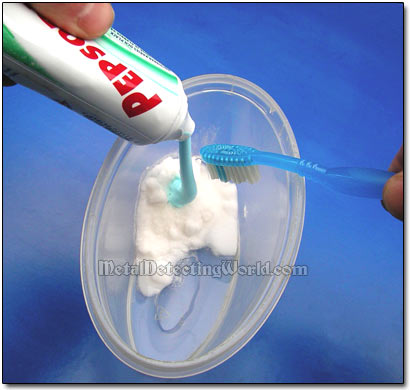How To Clean Coins and Jewelry with Electrolysis - A Detailed Tutorial, page 19
5. AFTER-ELECTROLYSIS COIN PRESERVATION
Coins usually have a very dull appearance after being cleaned with electrolysis. If they are just clad coins, rinse them well in water, dry, and hoard the coins in a big jar to be taken to a Coinstar self-service change converter machine at your local supermarket later.
If you plan to put your cleaned coin into your collection or sell it, you may want to do some coin conservation first. After you take the coin out of the electrolytic solution, brush it with a soft toothbrush and a baking soda/toothpaste mixture. Prepare such a mixture in advance by adding some toothpaste and a bit of water to baking soda.
Making a Mixture of Baking Soda, Toothpaste and Water

Applying this mixture will remove any remains of the electrolyte and brighten the coin. Then rinse the coin well in distilled water and immerse in acetone for a few minutes to remove any remaining water molecules. Being cleaned and dry, now your coin is very vulnerable to environmental effects. Now you either patinate or tarnish your coin to give it an "old" look, or simply preserve it with microcrystalline wax. The wax will seal the coin and help the coin details stand out a bit. Also rubbing the coin in olive or mineral oil can bring you the same effects. If you want to restore or see the worn former impressions on your coin, you can use techniques described on page 24 of my "Coin Cleaning Guide".
6. SAFETY PRECAUTIONS DURING ELECTROLYTIC CLEANING OF COINS
1) Dangerous Levels of Voltage and Current
In general, a voltage of less than 32 volts is not hazardous to the human body. At this voltage, there is little personal danger in using even metal vats.
So the voltage of an electrolytic setup is not of any concern unless one makes a terrible mistake by using "wall current" (the current that comes from a wall socket, also called household power, household electricity, house current, power line, domestic power, wall power, line power, AC power, hydro (in Canada), etc.), or any type of mains current for electrolysis - 110 or 220 volts will kill anyone in a flash!
DC CURRENT should be taken seriously because hazards of human exposure to electricity depend more on the current than the voltage. And the current resulting from a given voltage depends on the human body's resistance. If one's hands have unbroken, dry skin, their resistance is tens of thousands of ohms, and little or no current would pass through the body.
But if the skin is punctured or wet, the body resistance can be as low as one thousand ohms. In this case, if one holds an electrode in each hand, and sticks the hands in electrolytic solution for a while, even the low voltage of 10 to 15 volts could allow a dangerous level of current to flow across the human body.
Even a low current flowing through the human body may develop a reaction hazard caused by involuntary reaction to a mild shock. It can be a safety problem if reaction causes striking, falling, dropping, losing control, etc. Higher current can cause ventricular fibrillation or tissue damage resulting in injury or death. Typically it takes 10 or more milliamps driven through the body to start causing problems.
2) Avoid Getting Electrocuted
To avoid electrical hazards to your body, which are described above, follow these simple rules:
1) Always wear protective rubber gloves
2) Always turn off the power before making adjustments to the setup. Do not touch electrolyte, electrodes and coins being cleaned with bare hands at the same time when power is applied, otherwise you will receive a mild shock.
3) Do not use an unregulated power source such as a car battery. Use only a power supply with a current limit that can be regulated. A car battery charger best serves the purpose.
4) Avoid using a metal jar as both the container and the anode. It is easy to have an accidental contact and get electrocuted while working around an electrically "live" component of the electrolytic setup.